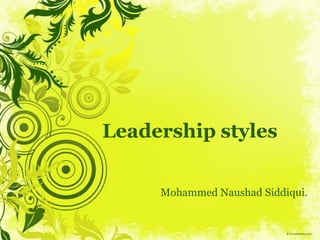
Leadership styles
- 1. Leadership styles Mohammed Naushad Siddiqui.
- 2. In this presentation we will learn - • Different styles of leadership. • Different approaches towards analysis of leadership and leader’s behaviour.
- 3. Classification based on the use of authority - Autocratic leaders – • Are authoritarian. • Gives order ( ideally , without any consultation at all) and expects it to be followed. • Works well if you don’t have much time to accomplish goals or • if employees are well motivated.
- 4. Democratic or participative leader - • Participative , consultative and persuasive style. • Encourages subordinates to take more participation in decision making process. • Workers feel like ownership and more participation and contribution in the firm. • The final decision making can be delayed as every decision is consulted alot.
- 5. Free rein leader - • Uses his / her power least. • ‘Let it be’ type – the leadership responsibilities are shared by all. • The subordinates are given high degree of freedom in their operations. • Is very useful in bussiness operations where a high degree of creativity is needed.
- 6. Analyzing leadership styles. A. The managerial grid. B. Leadership as continuum. C. Situational or contingency approach. D. The path-goal approach. E. Transformational leadership.
- 7. The managerial grid. • Very useful technique for analyzing leadership styles and behaviors. • 2 dimensional grid - concern for people and production. • The four corners of the grid -four extreme styles of leadership.
- 9. Leadership as continuum • Style of appropriate leadership depends upon- – leader himself/herself . – the followers . – the situation a leader faces. • According to this theory , the leader’s style is mainly influenced by – a) Forces in leader’s personality. b) Forces in subordinates. c) External environment or the situation leader confronts.
- 10. Contingency Approach Totally focussed on – study of situations. – leader’s response in the situation. • Recognizes interaction between leader and the group • Gives more strength to belief that leaders are made out of situation. • The leader’s effectiveness determined by how well his/her style fits the given context. • Realizes that leaders are NOT successful in all situations.
- 11. Leadership situation determined by 3 factors - Leader-member relations. Task structure. Position power. Fiedler proposed 2 major styles of leadership - a) Task oriented. b) Relations oriented.
- 12. LPC scale Asked to rate coworker on 16 sets of attributes like being pleasant , boring or interesting , rejecting or accepting , back biting or loyal , agreeable or disagreeable. High rating by coworkers indicates relationship oriented style. Low rating indicates task oriented leadership style.
- 14. Path-goal approach • Gives a lot of importance on situational factors affecting leadership. • Emphasizes relationship between leader’s style and characteristics of subordinates and work setting. • Main task of leader is to- a) Clarify and set goals. b) Help choosing the best path to achieve those goals. c) Remove obstacles from the path defined.
- 16. • Leadership Behaviors- • Directive leadership – Leader gives targets , sets instructions, expectations, deadlines, and performance standard. • Supportive Leadership – The leader is approachable and friendly , shows concern for the well being of his/her subordinates , treats everyone equally and avoids favouritism.
- 17. • Participative Leadership - Leader invites subordinates to give opinions, share ideas and includes their suggestions in the decision making process. • Achievement-Oriented Leadership - The Leader challenges subordinates to perform at the highest possible level. • Leader sets high standards of performance and excellence ,looks out for continuous improvement , shows confidence that subordinate will achieve high goals.
- 18. Transactional and transformational leadership. • Transactional leaders know what needs to be done to achieve goals. • Their main focus is on – 1. Procedures and efficiency. 2. Clarifying roles. 3. Setting up effective organization structure , rewards for performances. 4. Catering to social needs of their followers.
- 19. Transformational leaders. • Completely transform an organization by articulating a vision and inspiring followers. • Have a great capacity to motivate and create a favourable environment for organizational change and new organizational culture. • Believe in commanding only those things they themselves are perfect practitioners. • Are generally very selfless.
- 20. THANK YOU
